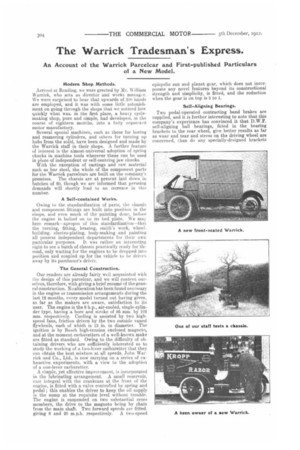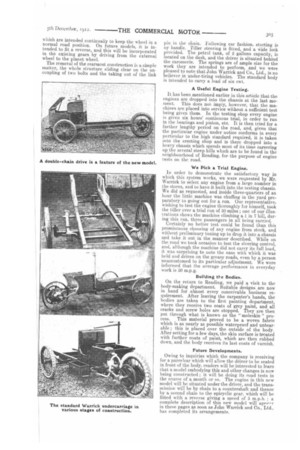The Warrick Tradesman' s Express.
Page 18

Page 19

If you've noticed an error in this article please click here to report it so we can fix it.
An Account of the Warrick Parcelcar and First-published Particulars of a New Model.
Modern Shop Methods.
Arrived at Reading, we were greeted by Mr. William Warrick, who acts as director and works managor. We were surprised to hear that upwards of 30u hands are employed, and it was with some little astonishment on going through the shops that we noticed how quickly what was, in the first place, a heavy cyclemaking shop, pure and simple, had developed, in the course of eighteen months, into a fully organiz.:..d motor rnanu factory.
Several special machines, such as those for boring and reamering cylinders, and others for turning up hubs from the solid, have been designed and made by the Warrick staff in their shops. A further feature of interest is the almost-universal adoption of spring chucks in machine tools wherever these can he used in place of independent or self-centring jaw chucks.
With the exception of castings and raw material such as bar steel, the whole of the component parts for the Warrick parcelcars are built on the company's premises. The chassis are at present laid down in batches of 20, though we are informed that pressing demands will shortly lead to an increase in this number.
A Self-contained Works.
Owing to the standardization of parts, the chassis and component fittings are built into position in the shops, and even much of the painting done, before the engine is bolted on to its bed plate. We may here remark—apropos of this standardization—that the turning, fitting, brazing, smith's work, wheelbuilding, electro-plating, body-making and painting all possess independent departMents for their own particular purposes. It was rather an interesting sight to see a batch of chassis practically ready for th. road, only waiting for the engines to be dropped into position and coupled up for the vehicle to be driven away by its purchaser's driver.
The General Construction.
Our readers are already fairly well acquainted with the design of this parcelcar, and we will content ourselves, therefore, with giving a brief resume of the general construction. No alteration has been found necessary in the engine or transmission arrangements during the last 12 months, every model turned out having given, as far as the makers are aware, satisfaction to its user. The engine is the 6 h.p., air-cooled, single-cylinder type, having a bore and stroke of 95 mm. by 102 mm. respectively. Cooling is assisted by two highspeed fans, friction driven by the two outside vaned flywheels, each of which is 13 in. in diameter. The ignition is by Bosch high-tension enclosed magnctn, and at the moment carburetters of a well-known make are fitted as standard. Owing to the difficulty of obtaining drivers who are sufficiently interested so to study the working of a two-lever carburetter that they can obtain the best mixture at all speeds, John Warrick and Co., Ltd., is now carrying on a series of exhaustive experiments, with a view to the adoption of a one-lever carburetter.
A simple, yet effective improvement, is incorporated in the lubricating arrangement. A small reservoir, east integral with the crankcase at the front of the engine, is fitted with a valve controlled by spring and pedal ; this enables the driver to keep the oil supply in the sump at the requisite level without trouble. The engine is suspended on two substantial cross members, the drive to the magneto being by chain from the main shaft. Two forward speeds are fitted. giving 8 and 20 m.p.h. respectively. A two-speed epicyclic sun and planet gear, which does not incorporate any novel features beyond its constructional strength and simplicity, is fitted, and the reduction when the gear is on top is 5 to 1.
Belt-Aligning Bearings.
Two pedal-operated contracting band brakes are supplied, and it is further interesting to note that this company's experience has convinced it that D.W.F. self-aligning ball bearings, fitted in the bearing brackets to the rear wheel, give better results as far as wear and tear and. stress on the driving wheel are concerned, than do any specially-designed brackets which are intended continually to keep the wheel in a normal road position. On future models, it is intended to fit a. reverse, and this will be incorporated in the existing gears by driving from the external wheel to the planet wheel.
The removal of the rearmost construction is a simple matter, the whole structure sliding clear on the uncoupling of two bolts and the taking out of the link pin irk the chain. Following car fashion, starting is lay handle. Tiller steering is fitted, and a Wide lock provided. The petrol tank, of 2 gallons capacity, is located on the dash, and the driver is situated behind the carosserie. The springs are of ample size for the work they are intended to perform, and we were pleased to note that John Warrick and Co., Ltd., is no believer in under-tiring vehicles. The standard body is intended to carry a load of six cwt.
A Useful Engine Testing.
It has been mentioned earlier in this article that the engines are dropped into the chassis at the last moment. This does not imply, however, that the machines are placed into service without a sufficient test being given them. In the testing shop every engine is given six hours' continuous trial, in order to run in the bearings and piston, etc. It is then tried for a further lengthy period on the road, and, given that the particular engine under notice conforms in every particular to the high standard required, it is taken into the erecting shop and is there dropped into a heavy chassis which spends most of its time careering up the several steep hills which are to be found in the neighbourhood of Reading, for the purpose of engine tests on the road.
We Pick a Trial Engine.
In order to demonstrate the satisfactory way in which this system works, we were requested by Mr. Warrick to select any engine from a large number in the stores, and to have it built into the testing chassis. We did as requested, and inside three-quarters of an hour the little machine was chuffing in the yard preparatory to going out for a run. Our representative, wishing to test the engine thoroughly for himself, took the tiller over a trial run of 30 miles ; one of our illustrations shows the machine climbing a 1 in. 7 hill, during this run, three passengers in all being carried. Certainly no better test could be found than this promiscuous choosing of any engine from stock, and without preliminary tuning up to drop it into a chassis and take it out in the manner described. While on the road we took occasion to test the steering control, and, although the machine did not carry its full load, it was surprising to note the ease with which it was held and driven on the greasy roads, even by a person unaccustomed to its particular adjustment. We were informed that the average performance in everyday work is 50 m.p.g.
Building tf.e Bodies.
On the return to Reading, we paid a visit to the body-making department. Suitable designs are now in hand for almost every conceivable business requirement. After leaving the carpenter's hands, the bodies are taken to the first painting department, where they receive two coats of grey paint, and all cracks and screw holes are stopped. They are then put through what is known as the " moleskin " pro cess. This material proved to be a, woven fabric which is as nearly as possible waterproof and untearable ; this is placed over the outside of the body. After setting for a few days, the skin surface is treated with further coats of paint, which are then rubbed down, and the body receives its last coats of varnish.
Future Developments.
Owing to inquiries which the company is receiving for a parcelcar which will allow the driver to be seated in front of the body, readers will be interested to learn that a model embodying this and other changes is now being constructed ; it will be doing its road tests in the course of a month or KO. The engine in this new model will be situated under the driver, and the transmission will be by chain to a countershaft and thence by a second chain to the epicyclic gear, which will be fitted with a reverse giving a speed of 5 m.p.h. ; a complete description of this new model will apness in these pages as soon as John Warrick and Co., Ltd., has completed its arrangements.


























